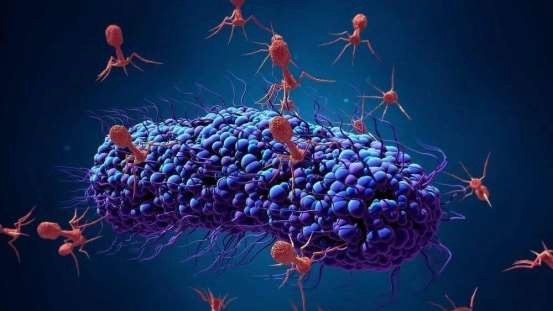随着基因技术的发展,人类对海洋病毒的认识逐渐深化:它们的数量和种类惊人,与之相比,海洋动物只能算“九牛一毛”;它们与周遭环境有着千丝万缕的联系,甚至有学者认为,它们才是影响生命进化和生物多样性的关键因素。据估算,海洋病毒的总数高达1030,如果把它们首尾相接,其长度相当于跨越了 60 个银河系。病毒的丰度占到了海洋中全部总和的 90%,其生物量也占到了海洋总生物量的5%,约为 200Mt,相当于七千五百万条蓝鲸所含碳的总和。
With the development of genetic technology, human understanding of marine viruses has gradually deepened: they are so numerous and diverse that marine animals are only “a drop in the bucket” compared with them; they are inextricably linked to their surroundings, and some scholars even believe that they are the key factor affecting the evolution of life and biodiversity. The total number of marine viruses is estimated to be 1030, which, if joined at the head and tail, would span the galaxy for 60 times. Viruses account for 90% of the total abundance and 5% of the total biomass of the ocean. They have a total weight of approximately 200 Mt, which is equivalent to the total carbon contained in 75 million blue whales.
海洋病毒个体微小,结构简单,主要由核酸(DNA或RNA)与蛋白质组成。其自身不能完成复制,但当它接触到宿主细胞后,会将其遗传物质(核酸)注入到宿主细胞体内,并借助宿主细胞的复制系统,进行子代病毒的复制。根据侵染的宿主类型,可以将海洋病毒分为噬菌体(细菌病毒)蓝细菌病毒(噬藻体)和真核藻类病毒等。研究表明绝大多数的海洋病毒为噬菌体。目前国际上对噬菌体有多种分类方式。例如,以核酸类型分为RNA病毒和DNA病毒,根据病毒包含的核酸链的类型分为甲链病毒和双链病毒,根据病毒颗粒的尾部形态学特征分为短尾病毒、长尾病毒和肌尾病毒,而根据噬菌体对宿主细胞的裂解特性又分为裂解性感染病毒。
Marine viruses are small and simple in structure, mainly composed of nucleic acids (DNA or RNA) and proteins. It can’t replicate itself, but when it comes into contact with a host cell, it injects its genetic material (nucleic acid) into the host cell and replicates the offspring virus with the help of the host cell’s replication system. According to the type of host infested, marine viruses can be classified as phage (bacteriophage), cyanobacterial viruses (phage) and eukaryotic algal viruses, etc. Studies have shown that the vast majority of marine viruses are phages. There are various ways to classify phages in the world. For example, they are classified as RNA and DNA viruses by the type of nucleic acid, as methyl-stranded and double-stranded viruses according to the type of nucleic acid chains, as podovirus, siphovirus and myovirus according to the morphological characteristics of the tails of virus particles, and as lytic infection viruses according to the lytic properties of phages on host cells.

海洋病毒的生态意义:病毒无法单独生存于环境中,它们必须依靠宿主细胞,通过侵染宿主后利用宿主体内的能量和物质进行繁殖。目前海洋中的病毒以裂解性侵染和溶原性侵染这两种方式进行生命循环。裂解性侵染是指病毒侵染到宿主细胞之后,会在较短时间之内,通过宿主的遗传机制和能量进行自身遗传物质的复制和蛋白质衣壳的合成,在完成装配之后会将宿主细胞裂解,将子代的病毒释放到环境中。溶原性侵染是指病毒侵染宿主细胞之后,并不会像裂解性侵染一样立即开始子代病毒的合成导致宿主死亡,而是将自身的遗传物质整合到宿主遗传物质上或者以质粒的形式存在,并且随着宿主细胞的复制而复制。
Ecological significance of marine viruses: Viruses can’t survive in the natural environment alone, and they must rely on host cells and reproduce by utilizing the energy and material of the hosts after infesting them. Currently, viruses in the ocean carry out their life cycle in two ways: lytic infestation and lysogenic infestation. Lytic infestation refers to the replication of genetic material and synthesis of protein capsids through the host’s genetic machinery and energy within a short period of time after the virus has infested the host cell, and then the host cell is lysed and the offspring virus is released into the environment. Lysogenic infestation means that after the virus has infested the host cell, it does not immediately start the synthesis of the offspring virus leading to the death of the host, but instead integrates its own genetic material into the host genetic material or exists in the form of plasmids and replicates as the host cell replicates.
多数的证据表明病毒导致的细菌死亡存在这使它成为微食物环的新成员。病毒裂解细菌会造成细菌所含的有机物释放到环境中,这部分有机物很快被异养细菌利用和呼吸,最终这部分有机物会被转化成二氧化碳、无机营养盐以及难以继续被利用的有机物质,从而形成了一个“有机物-异养细菌-有机物、营养物质”的完整回路。因此病毒裂解作用能将溶解态的营养物质保持在这个回路中循环,使碳元素以及其它生物元素远离更高的营养能级或者削弱向它们的传输通量。
Most evidence has shown that the virus can cause bacterial death, which makes it a new member of the microfood loop. Viral lysis of bacteria results in the release of organic matter contained in the bacteria into the environment, which is quickly used and respired by heterotrophic bacteria and eventually converted into carbon dioxide, inorganic nutrients, and organic matter that is difficult to be recycled, thus creating an “organic matter-heterotrophic bacteria-organic matter and nutrients” circuit. Viral lysis thus keeps dissolved nutrients circulating in this circuit, diverting carbon and other biogenic elements away from higher trophic energy levels or reducing the transport fluxes of carbon and other biogenic elements to them.
生物过滤海洋病毒:2020 年 3 月,荷兰皇家海洋研究学院海洋生物学家、博士后詹妮弗·威尔士在《科学报告》上发表了一项研究报告,对非宿主类海洋动物的抗 病毒能力进行了初步探究。“当病毒感染细胞以后,”詹妮弗称,“它会利用宿主产生新的病毒,这些病毒释放之后又会感染更多的细胞。”可对于很多非宿主海洋动物来说,海洋病毒却成了它们的果腹之物。詹妮弗在荷兰特克塞尔岛上的病毒生物学实验室里研究的所有“杀毒高手”中, 日本牡蛎仅排第四,前三甲 分别是海绵、螃蟹和鸟蛤,其中海绵在 3 个小时内清除了 94% 的病毒,而即 便每隔 20 分钟向水里添加新的病毒,海绵也能不断将其迅速“吃干净”。
Biofiltering marine viruses: In March 2020, Jennifer Welsh, a postdoctoral fellow and marine biologist at the Royal Netherlands Institute for Sea Research, published a report in Scientific Reports, providing a preliminary probe into the resistance of non-host marine animals to viruses. “After a virus infects a cell,” Jennifer claimed, “it uses the host to produce new viruses, which are released and then infect more cells.” But for many non-host marine animals, marine viruses become a fruitful source of food. Of all the “viral killers” Jennifer studied in her lab on the Texel Island, the Japanese oyster only ranked fourth, following sponges, crabs and cockles. Even when new viruses were added to the water every 20 minutes, the sponges can continue to “eat” them up quickly.

该项研究对防止海水养殖带来的海洋污染提供了新的思路。在海洋农场,鱼类或贝类等数量庞大的单一物种被圈养了起来,而它们所在水体又与海洋直接相通,一旦出现病毒爆发,很可能会蔓延到海洋中危害其他野生物种。增加海绵之后,病毒爆发的威胁就可能被消灭在萌芽状态。
The study offers new ideas for preventing marine pollution from mariculture. In marine ranching, where large numbers of single species such as fish or shellfish are cultivated but the water bodies are directly connected to the ocean, a virus outbreak could spread to the ocean and harm other wild species. After adding sponges, the threat of a virus outbreak could be stifled in the cradle.
参考资料:
[1] 谢乐, 病毒对海洋生态系统的影响:数据分析及数值模型研究[D].厦门:厦门大学,
2018
[2] 沈川, 过滤海洋病毒,海洋生物有一手[J].环境与生活,2020,(05),92-96
References:
[1] Le Xie. The influence of virus on marine ecosystems: Data analysis and ecosystem modelling study [D]. Xiamen: Xiamen University, 2018
[2] Chuan Shen. Marine organisms are highly skilled at filtering marine viruses [J]. Green Living, 2020,(05),92-96
 公众号
公众号